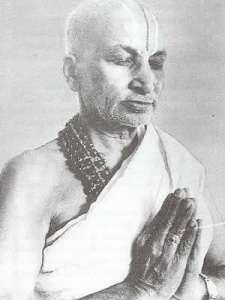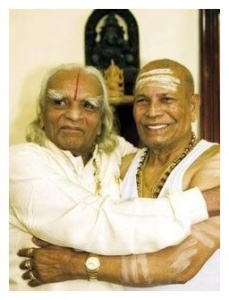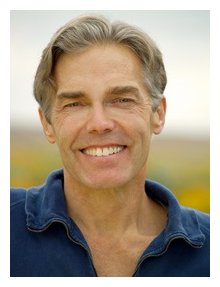About Ashtanga Vinyasa Yoga

The current series in the Ashtanga Vinyasa system were developed by T. Krishnamacharaya around the internal principles of vinyasa found in the ancient Indian text, the “Yoga Kurunta”de Vamana Rishi.
He instructed his student K. Pattabhi Jois of Mysore, South India to master and to use these series in teaching the Ashtanga Vinyasa system..
These living lineages come to us directly through T. Krishnamacharaya and K. Pattabhi Jois drawing the potent thread of yoga into the present from thousands of years since its formulation in Ancient India.
The practice allows us to see through the workings of our own minds, to ground our experience in the present moment and to have a compassionate and clear understanding of the ideas, beliefs and rituals which surround our yoga practice and daily lives.
Ethical conduct, honesty and compassion are at Heart of the Practice.
As part of the asana practice, core strength and alignment are accessed by integrating movement with the structural patterns along the central axis of the body. This is accomplished by meditation on the structural tones in the pelvic floor which balance the body and open its midline into deep direct experience of the life process. In this way one can establish a genuine ground for the further practices of pranayama, opening of internal energy channels, awakening of kundalini, and meditation.
“The purpose of a practice is to expose reality.” (Richard Freeman)
Within the Ashtanga Vinyasa system postures are linked together through flowing movement (vinyasa), and the joining of that movement with the gaze, the breath and the currents of internal sensations.
There are seven formal series of postures which are each practiced in sequential flow. All series begin with the Sun Salutations and contain the same standing postures. All end with the same finishing sequence. The postures sandwiched between vary from series to series, and are designed to address specific issues, such as structural integration, cleaning the nadis, or strengthening the internal mudras.
All postures are linked together through the breath into a continuous flow or sequence (Vinyasa) of movements.
Most students practice the Primary or Intermediate series, and a few advanced students work into the Advanced series, the heart of the practice.
What does “dristi” mean?
Each pose has a preferred gazing point (dristi). The gaze is soft and focused, never gripping nor darting. The perfection of dristi is to see infinity. They are 9 dristis :

- Hastagra : hand or tip of fingers
- Bhrumadhya : between the eye brows
- Padangustha : big toe
- Parsva : sidesways
- Nasagra : tip of the nose
- Urdhva ou antara : upwards
- Angustha : thumbs
- Nabhi chakra : navel
- Adho mukha dristi : down on the floor
The Asana.
The practice of yoga asana, or postures, is one of the eight limbs of traditional Ashtanga yoga.
The flowing form of Ashtanga Vinyasa yoga, in which postures are practiced in a continuous flowing sequence, strung together on the thread of the breath.
We study closely the internal forms of the practice — the breath, gaze, mudra (joining together) and bandha (holding in concentration) — that allow for a strong and meditative practice to spontaneously arise.
Ashtanga Vinyasa yoga has become known for its intensity and rigor because the flowing form allows students to work “on their edge”. It demands concentration of mind which causes internal heat (tapas) to arise in the body which can cause sweating.
So one has to go back into the internal forms that lie along the central channel of the body, allowing the mind and ego to be released as the asana deepens.
This results in a practice that is safe, healing, and appropriate for each individual’s body and life circumstance.
The continuous linking of the postures with the movement of the breath balances structural and mental patterns resulting in strength, flexibility and radiant health. The practice then spontaneously awakens the central axis of the body bringing the mind into deep meditation.
Richard Freeman www.yogaworkshop.com
A propos de l’Ashtanga Vinyasa Yoga.

Les séries actuelles du système de l’Ashtanga Vinyasa furent développées par T. Krishnamacharya autour des principes internes du vinyasa découvert dans l ancien texte Sanskrit : Le Yoga Kurunta de Vamana Rishi.
Il enseigna à son élève K.Pattabhi Jois de Mysore, en Inde du sud, de maîtriser et d’utiliser ces séries dans l’enseignement du système de l’Ashtanga Vinyasa.
Ces lignées vivantes viennent à nous directement au travers de T. Krishnamarachya et de K.Pattabhi Jois dessinant le puissant fil du Yoga dans le présent depuis sa formulation il y a des milliers d’années dans l’Inde Ancienne.
La pratique nous permet de voir au travers des mécanismes de nos propres esprits, d’enraciner notre expérience dans le moment présent et d’avoir une compréhension compatissante et claire sur les idées, les croyances et les rituels qui entourent notre pratique de Yoga et notre vie de tous les jours.
Une conduite éthique, l’honnêteté et la compassion sont le Cœur de la pratique.
En ce qui concerne la pratique des asanas, on accède à la force centrale et à l’alignement, en intégrant les mouvements avec les schémas structurels le long de l’axe central du corps.
Ceci est accompli en méditant sur les tonicités structurelles dans le plancher pelvien, ce qui équilibre le corps et ouvre sa ligne centrale dans l’expérience profonde et directe du processus de la vie.
De cette façon, on peut établir un terrain authentique pour les pratiques plus poussées de Pranayama, d’ouverture des canaux d énergie interne, l’éveil de la Kundalini et la méditation.

“Le but de la pratique est d’exposer la réalité.” Richard Freeman
Dans le système Ashtanga Vinyasa, toutes les postures sont liées entre elles par le fil de la respiration dans un flot continu (ou séquence) de mouvements : le vinyasa (vi=bouger ; nyasa =se placer).
Les formes internes de l’Ashtanga Yoga utilisant les bandhas, les mudras, le regard, la respiration Ujayi et le Vinyasa sont les caractéristiques de cette forme de Yoga.
Il y a 7 séries formelles de postures qui sont chacune pratiquées dans un flot séquentiel. Chaque série débute avec les Salutations au Soleil et contient les mêmes postures debout. Chacune finit avec la même séquence finale. Les postures prises «en sandwich» au milieu varient de série en série et sont conçues pour s’adresser à des aspects différents, comme l’intégration structurale, le nettoyage des nadis ou le renforcement des mudras internes.
Qu’est-ce que le “Dristi”?
Chaque posture a un regard spécifique. Le regard est doux et concentré, jamais accrocheur ou dardant. La perfection du Dristi est de contempler l’Infini. Il y a 9 dristis :
- Hastagra :la main ou le bout des doigts
- Bhrumadhya : 3 ème œil –entre les sourcils
- Padangustha : gros orteil
- Parsva : de côté
- Nasagra : bout du nez
- Urdhva ou antara : vers le haut
- Angustha : les pouces
- Nabhi chakra : le nombril
- Adho mukha dristi : vers le sol
Asana.
La pratique des postures de Yoga ou asanas, est une des huit branches de l’Ashtanga Yoga.
Dans l’Ashtanga Vinyasa Yoga, les postures sont enchaînées «en flow» et en séquences, liées entre elle par le fil du souffle.
En cultivant les formes internes de la pratique : la respiration Ujayi, les dristis, les mudras (joindre ensemble) et les bandhas (tenir en concentration), un état méditatif puissant et profond apparaît spontanément.
L’Ashtanga Vinyasa Yoga est reconnu pour son intensité et rigueur parce que sa forme fluide permet aux élèves de travailler à leurs limites.
Cela demande concentration du mental, qui engendre de la chaleur interne (tapas) dans le corps qui peut causer de la sueur.
Quand les postures sont difficiles, il faut revenir encore et encore aux formes internes qui résident le long du canal central du corps, et qui permettent de relâcher le mental et l’ego alors que la posture s’approfondit.
Ceci permet d’avoir une pratique qui est sûre, guérisseuse et appropriée pour chaque personne et chaque circonstance de la vie.
La continuelle jonction des postures avec les mouvements de la respiration équilibre les schémas structurels et mentaux et engendre force, souplesse une santé rayonnante.
La pratique alors réveille spontanément l’axe central du corps emmenant l’esprit en méditation profonde.
Richard Freeman www.yogaworkshop.com